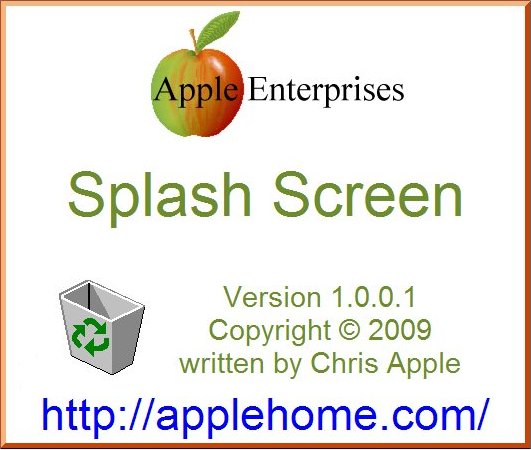Introduction
Every application needs an “about box” and some need a “splash screen” while loading. Most developers use the boring “about dialog” that is created automatically. I created the class, CSplashScreen, to handle both, to make them less error prone and to make them more interesting. I use this class for programs from tiny dialog applets to complex applications that take a couple of minutes to load and initialize.
The class consists of two files, SplashScreen.h and SplashScreen.cpp. The class does not require MFC or .NET. I have another class that uses MFC.
The class gets all the information to display the splash screen from a bitmap and the version strings in the resources. Therefore, you don’t have to modify the splash screen every time the version changes.
The splash screen disappears when clicked on, a key is pressed, or the desired time has elapsed.
Splash Screen Example
|

|
Using the code
- Include SplashScreen.h and SplashScreen.cpp.
- Add version strings to the resources.
- Add the
IDB_SPLASH bitmap to the resources. - Add version.lib to the link libraries.
ShowSplashScreen(HWND pParentWnd, LPCTSTR statusMessage, int millisecondsToDisplay) can have zero to three parameters.
pParentWnd - parent window of splash screen statusMessage - string to display in status area of splash screen millisecondsToDisplay - number of milliseconds before hiding splash screen
To show the splash screen during initialization, add CSplashScreen::ShowSplashScreen();.
#include "SplashScreen.h"
int APIENTRY WinMain(HINSTANCE hInstance,
HINSTANCE hPrevInstance,
LPSTR lpCmdLine,
int nCmdShow)
{
MSG msg;
CSplashScreen::ShowSplashScreen( hWnd, "http://applehome.com/", 10000);
.
.
.
while (GetMessage(&msg, NULL, 0, 0)) {
if (!TranslateAccelerator(msg.hwnd, hAccelTable, &msg)) {
TranslateMessage(&msg);
DispatchMessage(&msg);
}
}
return msg.wParam;
}
To show the about box, add CSplashScreen::ShowSplashScreen() to WndProc(…):
#include "SplashScreen.h"
LRESULT CALLBACK WndProc(HWND hWnd, UINT message, WPARAM wParam, LPARAM lParam)
{
switch (message) {
case WM_COMMAND:
switch (LOWORD(wParam)) {
case IDM_ABOUT:
CSplashScreen::ShowSplashScreen( hWnd );
break;
}
break;
default:
return DefWindowProc(hWnd, message, wParam, lParam);
}
return 0;
}
Under the hood
Since I’m a consultant, I create a specialized bitmap for each client. I typically place the company logo and the application icon in the IDB_SPLASH bitmap. Depending on your artistic talent, you can make a very professional splash screen. The version strings are written on top of the bitmap.
There are 3 groupings of strings: Product Name, Body, and Status. The Body consists of one or more of the company name, version, copyright, and comment strings. I prefer the product name to be larger, with the multiple lines of the body smaller. I use Status only when the application is loading.
Each group has static variables that specify how the strings in that group are drawn:
m_xxxVerticalOffset - empty space between the top of the bitmap and the first string m_xxxVerticalHeight - the maximum height of a group of strings m_xxxLeftMargin - the distance from the left side to the place strings m_xxxRightMargin - the distance from the right side to strings m_xxxFontName - the name of the font for strings m_xxxPointSize - the point size used for strings, (-1,-1) ==> Calculate point size m_xxxTextColor - the color used for strings
The body can have from 0 to 4 strings. Set the static display variables:
m_displayCompanyName - true if displaying company name m_displayVersion - true if displaying version m_displayCopyright - true if displaying copyright m_displayComments - true if displaying comments
The CSplashScreen class is instantiated when CSplashScreen::ShowSplashScreen() is called. It is deleted when the timeout elapses, a key is pressed, or the the mouse is clicked.
History
- Date posted: April 21, 2009
I have been a software consultant at Apple Enterprises, http://applehome.com/, since 1981, a paid programmer since 1975 and a programmer since 1969 when I took my first programming class at U.C. Berkeley. I graduated with an EECS degree in 1975 after a 2 year hiatus in the US Marine Corps as a infantry machine gunner.
I started working when the original Intel 8080 microprocessor was announced. My first product was a wire bonder that had four 8080 microprocessors controlling high speed motors. Lately I have been using the TI MSP430, NXP LPC2300 and the Renesas SH4 microcontrollers.
I write code in assembly, C, C++ and Java and occasionally design a board when needed. Most of the time the code is system level, low level and drivers, but I do write applications. Most embedded devices usually have a PC controller application that I write. The code is used in Windows, Windows CE and proprietary operating systems. I use Visual Studio 2008, IAR and Keil IDEs. I even create single click installations, especially complex ones that require third party installs.
I have developed over 50 products.
I host the UC Berkeley Engineering Alumni Society (South Bay):
http://www.linkedin.com/groups?gid=1851655
http://www.facebook.com/reqs.php#/group.php?gid=57293762711
I live in Silicon Valley, play full court basketball once a week, work out at the gym during the week and hike with my wife on the weekend.
 General
General  News
News  Suggestion
Suggestion  Question
Question  Bug
Bug  Answer
Answer  Joke
Joke  Praise
Praise  Rant
Rant  Admin
Admin 







